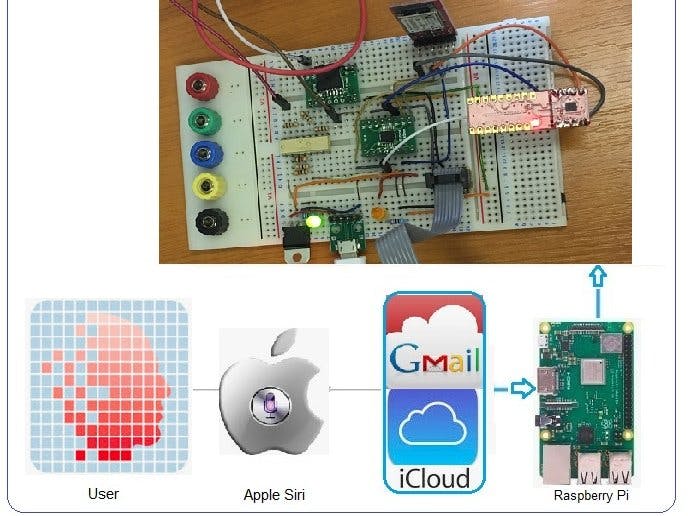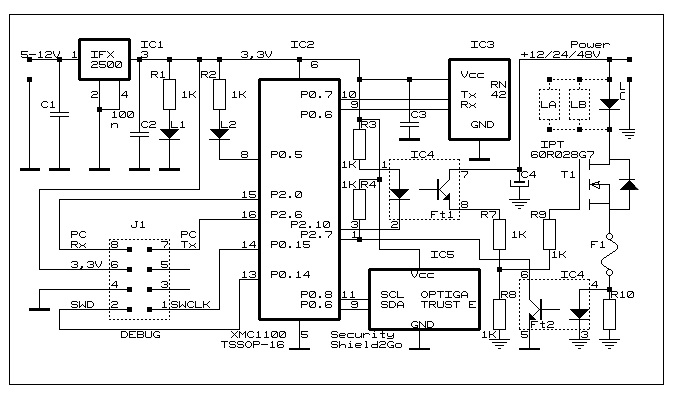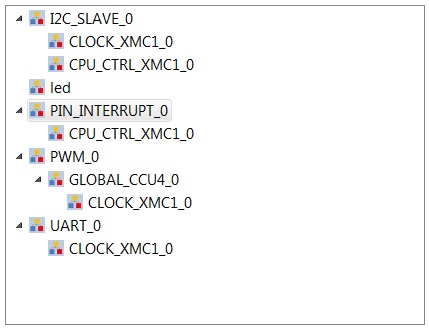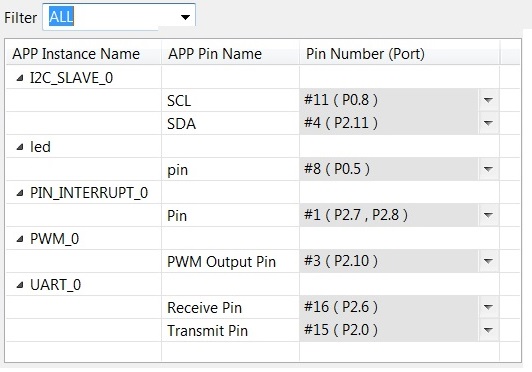Cloud-based voice recognition systems require dedicated actuators for real-world applications. ManyDC-powered actuators such as vehicle lights, medical actuators, household applications can be activated by voice. The development ofthese types of applications ultimately requires an active programmable switch that activates or deactivates the executionelement (DC motors, power LEDs, relays etc.).
The solution is based on the use of an Infineon XMC 1100 industrial microcontroller interconnected with a BlueTooth module, a galvanic isolation circuit that activates the 600V Cool MOS G7 PowerTransistor used as a DC switch. The software application developed in Infineon DAVE will interpret the message received by BT/UART and provide suitable control signals for the final transistor. The core can also be configured to communicate through the LIN protocol if it is intended to develop a car switch.
For embedded security is included an Infineon’sShield2Go Security OPTIGA™ Trust E. The experimental test will be carried out on a car lighting system using Apple Siri for speech processing.
The command words are pronounced in front of an iPhone on which the Siri application is activated. This will provide Note messages to a Gmail user. Raspberry Pi runs a Python-based Siricontrol-System software with control modules. It extracts Notes from the Gmail user, identifies command words and sends specific execution messages to the prototype system SBS (Siri Based Switch) made on a breadboard. The SBS represented in Figure 2 is designed so that it can be easily replicated and allows specific software development. The central element is an Infineon XMC1100 MCU [3] made in the TSSOP 16 capsule that can be easily connected with a standard breadboard extension.
It is based on Arm Cortex-M0 with a 32-bit CPU and 64Kb Flash memory for programs, 16Ko of RAM, serial communication interfaces (UART, I2C, SPI, ) timers, analogue / digital converter, random number generator, etc.
The circuit IC1 is a voltage regulator for 3.3V. The IC3 module is a Bluetooth RN42 communication interface. The activation of the Infineon 600VCoolMOSªG7PowerTransistor T1 is made with an optocoupler, IC4, which has also the function of introducing a galvanic separation between the programmable controller part and the power consumer part. The galvanic isolation allows to reduce the noise that can be introduced by the common ground. The optocoupler command is performed with PWM (Pulse Width Modulation) signals generated at port P2.0.
The Ft1 phototransistor from IC4 with resistors R7 and R8 ensures acorrect potential for activating the gate of the transistor T1 usedas a power switch. The voltage divider made with R7 and R7 I can be resized depending on the supply voltage of the consumers (12-24-48V). The current values are for 12 voltautomotive power lights. The experimental system is exemplified on the control of the headlights of a car. It can use classical filament lamps (LA), laser lamps (LB) or LED lamps (LC). In the case of LA lamps, it is necessary to insert an F1 fuse that will provide protection against short circuits.
Optionally, depending on the current consumed by the lamp, it is possible to insert the resistor R10 used to limit the current. If consumption increases so that the voltage on R10 exceeds 2-2, 5V activates phototransistor Ft2 from IC4 witch will generate an interrupt on pin P2.7. The interrupt handler changes the duty cycle of the PWM signal applied to the gate of thetransistor T1.
Software development for Siri-based switch can be done in C ++ from Infineon DAVE. The code transfer inflash memory and DEBUG operations are possible via an SEGGER J-Linkd debugger and UART virtual COM port. It is detached from the Infineon XMC110 Boot kit and the transfer of the code is ensured via the J18-pin connector. SWD (Serial Wire Data) is connected to pin P0.14and SWCLK (Serial Wire Clock) is connected to P0.15. To execute the code after reset BMI (Boot Mode Index) of the XMC1100 is set to User Mode.
The Debug module supports communication between a PC and target XMC device via Virtual COM Port (UART-to-USB Bridge) using P2.0 as transmiter and P2.6 as receiver.
Connected via USB to Raspberry, this link will be visible in Linux as a tty named ACM0. Using this connection, it is easy totest the good functioning of the SBS module.
Wireless communication between theRaspberry Pi and SBS can be achieved by two paired RN42 Bluetooth modules.
For further authentication and brand protection development the system includes an Infineon Shield2Go Security OPTIGA™ Trust E module connected with I2C (IFX) protocol at P0.8 and P0.6 pins. These devices allow primarily implementation of one-way authentication protocol exploiting properties of asymmetric cryptographic algorithms [7].
Apple iPhone Siri Control on Raspberry PiThe iPhone "hey siri" call followed by the word "Notes" will allow the following spoken words to be converted to ASCII format and sent to a Gmail user attached to Apple iCloud. Details of making such connections and Siri for Raspberry Pi resources are available at [4].
The Python application calledSiricontrol-System [5] with the name and password of the Gmail user extracts the messages from the Gmail Notes section and searches for the command words specified in the Python programs located in theModules folder and executes the related functions.
For the experimental test application, the command words are the following:”light first”, ”light middle”, ”light huge”, ”light stop”. These can be viewed on Gmail inthe Notes section shown in figure 5:
Realated Links1. IFXCoolMOSTMG7Webpage:www.infineon.com
2. IFXCoolMOSTMG7applicationnote:www.infineon.com
3. XMC1100 ref. Manual :https://www.infineon.com/dgdl/Infineon-xmc1100-AA_rm-UM-v01_01-EN.pdf?fileId=5546d46255dd933d0155e31753b077af
4. SiriControl tutorial: https://www.raspberrypi.org/magpi/siricontrol-control-raspberry-pi-siri/
5. Siricontrol-System software:https://github.com/theraspberryguy/SiriControl-System
6. Infineon DAVE: https://infineoncommunity.com/dave-download_ID645
7. Infineon OPTIGA Trust: https://www.infineon.com/cms/en/product/security-smart-card-solutions/optiga-embedded-security-solutions/optiga-trust/











Comments
Please log in or sign up to comment.